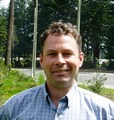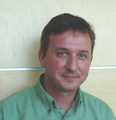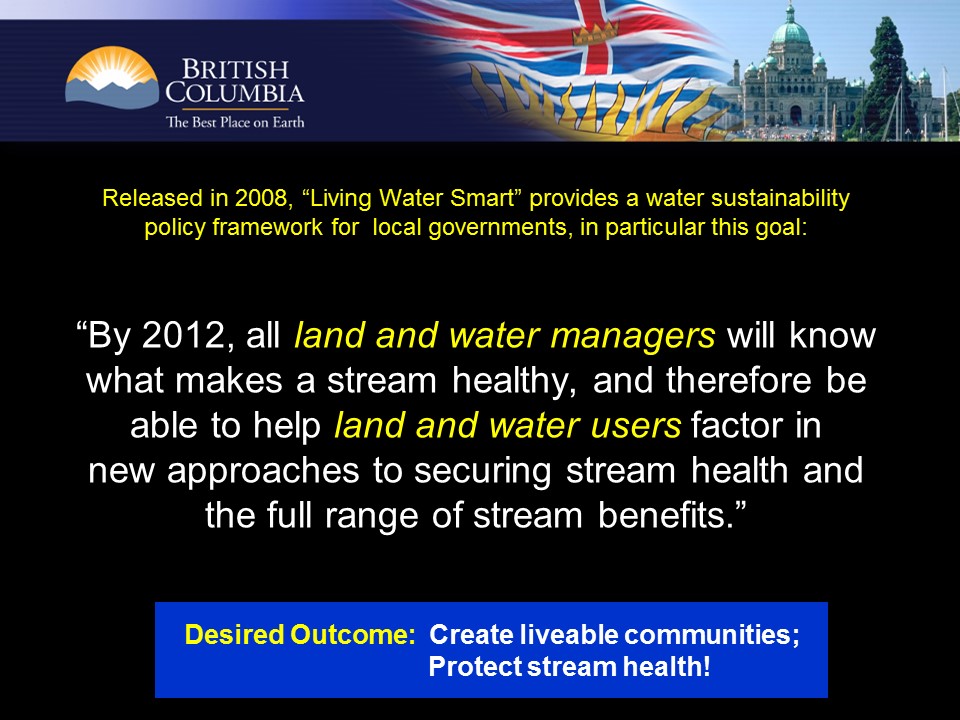FLASHBACK TO 2008: Case study applications of Water Balance Model showcased at capacity-building forum hosted by Cowichan Valley Regional District (Oct 2008)
Cowichan Valley Forum – provincial pilot for building developer and local government capacity to apply the Water Balance Model
In October 2008, the Cowichan Valley Regional District (CVRD) hosted a ‘by invitation only’ Water Balance Model Forum in collaboration with the Inter-Governmental Partnership.
The Forum was organized under the umbrella of CAVI – Convening for Action on Vancouver Island. The Forum featured a roundtable sharing of case study experience related to achieving runoff-based performance targets.
 “The provincial and regional water regulations are changing, and by 2012 provincial water laws will substantially change how development occurs. The purpose of the workshop is to review progressive rainwater/stormwater management techniques and how they can be incorporated into the planning and development process,” wrote Jack Peake, Chair of the Cowichan Valley Regional Board, in his letter of invitation to land developers and consultants.
“The provincial and regional water regulations are changing, and by 2012 provincial water laws will substantially change how development occurs. The purpose of the workshop is to review progressive rainwater/stormwater management techniques and how they can be incorporated into the planning and development process,” wrote Jack Peake, Chair of the Cowichan Valley Regional Board, in his letter of invitation to land developers and consultants.
To Learn More:
Download Announcement for Cowichan Water Balance Forum – October 2008.
Download a copy of the Invitation from the Chair of the Cowichan Valley Regional Board.
Download a copy of the Cowichan WBM Forum – Agenda.
Living Water Smart: Doing Business Differently in BC
The Cowichan Valley Water Balance Model Forum was part of the early implementation program for Beyond the Guidebook: The New Business As Usual.
This initiative has added depth to Living Water Smart, the provincial government’s vision and plan to keep British Columbia’s water healthy and secure for the future.
Forum featured case study applications at three scales: watershed, neighbourhood and site
“The Cowichan Valley is the pilot region for an inclusive and collaborative approach to building capacity through education and training,” stated Jay Bradley (Ministry of Agriculture & Lands) in his contextual remarks at the Forum. Jay Bradley was Chair of the former Vancouver Island Coordinating Team, a sub-group of the Inter- Governmental Water Balance Model Partnership.
Governmental Water Balance Model Partnership.
“To meet the diverse information needs of invitees, the Forum is designed as a hybrid-training workshop. This allows us to inform, educate and enable those who wish to apply the Water Balance Model to support a Design with Nature approach to land development.”
The day was built around case study demonstrations of the Water Balance Model.
These provided the technical foundation for roundtable sharing of ideas on ‘how to’ achieve runoff-based performance targets for developments, the “New Business as Usual” for rainwater management and green infrastructure.
Inclusive and Collaborative Approach
 “The case study applications will build a common understanding of how to achieve runoff-based performance targets for rainwater management and green infrastructure,” stated Rob Conway, Assistant Manager, CVRD Development Services.
“The case study applications will build a common understanding of how to achieve runoff-based performance targets for rainwater management and green infrastructure,” stated Rob Conway, Assistant Manager, CVRD Development Services.
“What is unique about our approach is the educational context. Willing owners/developers and their planning/design consultants have volunteered to develop and share the case studies. It truly is a collaborative effort.”
To provide a reality-check on the brainstorming, three developer-consultant teams were asked to apply the WBM beforehand at three scales:
- Single family site
- Large commercial development
- Residential neighbourhood
 “The desired outcome is that development proponents would understand how to use the WBM as a decision support tool to help them meet targets, and local government reviewers would understand what the results mean,” stated Kim Stephens, Forum coordinator and Project Manager for the Water Balance Model initiative.
“The desired outcome is that development proponents would understand how to use the WBM as a decision support tool to help them meet targets, and local government reviewers would understand what the results mean,” stated Kim Stephens, Forum coordinator and Project Manager for the Water Balance Model initiative.
“The Water Balance Model helps us solve the right problem. The desired outcome is to create liveable communities and protect stream health.”
To Learn More:
Visit the Vancouver Island community-of-interest:
https://waterbucket.ca/viw/category/convening-for-action-in-2008/2008-cowichan-valley-water-balance-model-forum/





